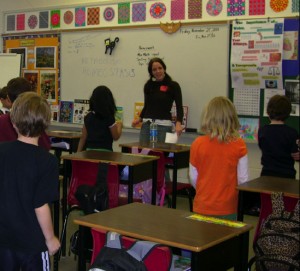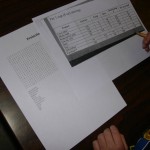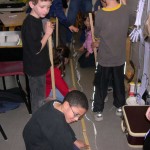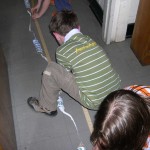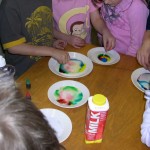Prolactin
October 6, 2011 in Peptide
Monday, April 23rd, 2007, Halifax, NS, 2nd graders were intrigued by the mixing and movements of color dye in a plate of milk as the team of Ted Abraham (BSc, SMU) and Wes Johnston (BFA, NSCADU) introduced the peptide prolactin, which they explained causes milk production. The students showed their own knowledge about the different kinds of milk, from both plant (soy milk) and animal (i.e. cow, goat, buffalo, llama and human) sources. Engaging the students in a poster about prolactin and a chart about the components of various kinds of milk, Ted relayed how different kinds of milk have different amounts of fat, calcium, energy and vitamins. Cutting shapes from card board tubes and paper cups, Wes guided the students in how to synthesize a peptide chain from alpha-helix and random coil secondary structures. Combining the helices and coils together, the students constructed a giant peptide chain, which they measured to be 10 meters long (now that’s a big peptide!). Milking the prolactin moment, the students grasped why polactin levels are usually very low in men and why in women, prolactin levels increase to a maximum immediately after childbirth. In addition, they were reminded that oxytocin, another peptide (shaped like a lasso) causes milk release called lactation.
Finishing our third MLP presentation in 2007, (10th total!!), team prolactin was thanked for a crème de la crème MLP experience in 2nd grade in Halifax.
Team Prolactin, Ted Abraham (BSc, SMU) and Wes Johnston (BFA, NSCADU) fielding questions on milk.
Exploring the influence of soap on color dyes floating on different kinds of milk.


